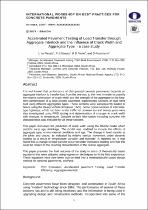 ResearchSpace
ResearchSpace
Accelerated pavement testing of load transfer through aggregate interlock and the influence of crack width and aggregate type - a case study
JavaScript is disabled for your browser. Some features of this site may not work without it.
- ResearchSpace
- →
- Research Publications/Outputs
- →
- Conference Publications
- →
- View Item
| dc.contributor.author |
Du Plessis, L

|
|
| dc.contributor.author |
Strauss, PJ

|
|
| dc.contributor.author |
Perrie, BD

|
|
| dc.contributor.author |
Rossmann, D

|
|
| dc.date.accessioned | 2007-11-08T08:10:01Z | |
| dc.date.available | 2007-11-08T08:10:01Z | |
| dc.date.issued | 2007-10 | |
| dc.identifier.citation | Du Plessis, L et al. 2007. Accelerated pavement testing of load transfer through aggregate interlock and the influence of crack width and aggregate type - a case study. International workshop on best practices for concrete pavements; Recife, Brazil, 21-23 October, 2007, pp 21 | en |
| dc.identifier.uri | http://hdl.handle.net/10204/1457 | |
| dc.description | 2007: International workshop on best practices for concrete pavements | en |
| dc.description.abstract | This paper discusses the prediction of crack width using the International Union of Laboratories and Experts in Construction Materials, Systems and Structures (RILEM) model which predicts early age shrinkage. The model was modified to include the effects of aggregate type, environmental conditions and age. The change in load transfer at the joints and cracks, as indicated by relative vertical movement under dynamic loading as a result of temperature variation and humidity, is reported on. The paper presents the final outcome of the study in terms of theoretically based equations that were adjusted using regression techniques to fit the filed experience. These equations have now been incorporated into a mechanistically-based design method for concrete pavements, cncPave | en |
| dc.language.iso | en | en |
| dc.subject | Accelerated pavement testing | en |
| dc.subject | Load transfer efficiency | en |
| dc.subject | Aggregate interlock | en |
| dc.title | Accelerated pavement testing of load transfer through aggregate interlock and the influence of crack width and aggregate type - a case study | en |
| dc.type | Conference Presentation | en |
| dc.identifier.apacitation | Du Plessis, L., Strauss, P., Perrie, B., & Rossmann, D. (2007). Accelerated pavement testing of load transfer through aggregate interlock and the influence of crack width and aggregate type - a case study. http://hdl.handle.net/10204/1457 | en_ZA |
| dc.identifier.chicagocitation | Du Plessis, L, PJ Strauss, BD Perrie, and D Rossmann. "Accelerated pavement testing of load transfer through aggregate interlock and the influence of crack width and aggregate type - a case study." (2007): http://hdl.handle.net/10204/1457 | en_ZA |
| dc.identifier.vancouvercitation | Du Plessis L, Strauss P, Perrie B, Rossmann D, Accelerated pavement testing of load transfer through aggregate interlock and the influence of crack width and aggregate type - a case study; 2007. http://hdl.handle.net/10204/1457 . | en_ZA |
| dc.identifier.ris | TY - Conference Presentation AU - Du Plessis, L AU - Strauss, PJ AU - Perrie, BD AU - Rossmann, D AB - This paper discusses the prediction of crack width using the International Union of Laboratories and Experts in Construction Materials, Systems and Structures (RILEM) model which predicts early age shrinkage. The model was modified to include the effects of aggregate type, environmental conditions and age. The change in load transfer at the joints and cracks, as indicated by relative vertical movement under dynamic loading as a result of temperature variation and humidity, is reported on. The paper presents the final outcome of the study in terms of theoretically based equations that were adjusted using regression techniques to fit the filed experience. These equations have now been incorporated into a mechanistically-based design method for concrete pavements, cncPave DA - 2007-10 DB - ResearchSpace DP - CSIR KW - Accelerated pavement testing KW - Load transfer efficiency KW - Aggregate interlock LK - https://researchspace.csir.co.za PY - 2007 T1 - Accelerated pavement testing of load transfer through aggregate interlock and the influence of crack width and aggregate type - a case study TI - Accelerated pavement testing of load transfer through aggregate interlock and the influence of crack width and aggregate type - a case study UR - http://hdl.handle.net/10204/1457 ER - | en_ZA |





